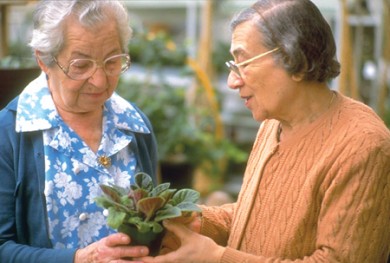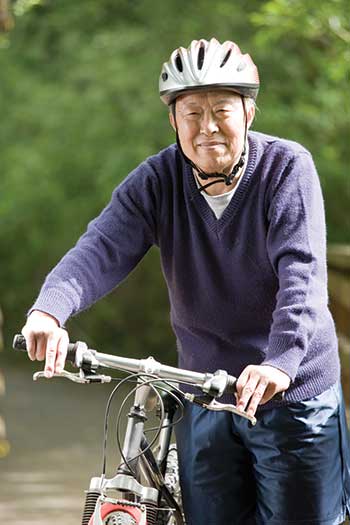What’s stopping me from being active?
Here is a list of the top 10 barriers for older adults, as reported by The Canadian Fitness and Lifestyle Research Institute:
- Not enough energy
- Lack of motivation
- Illness or injury
- Fear of injury
- Lack of skill
- Not enough time
- Ill at ease
- Lack of facilities
- Cost
- Lack of safe places
Many of us feel that we are too tired to be active. But once they get started, most people say that physical activity helps them feel better and gives them more energy.
Do it because you enjoy it
The key is to choose activities that you enjoy. Why? Because it will motivate you. Here are some examples:
- Do you like to dance? Why not turn on some music and move to the beat?
- Do you like nature? Go for a walk and take in the scenery.
- Do you like gardening? No yard? Try a balcony garden.
Being active can help you relax. It can also keep you independent longer. Staying active is important to your physical and mental health. Here are some more examples of things that you might like to do:
- Wash and wax your car.
- Take your grandchildren for a walk.
- Use a wheelchair? No problem — ‘wheeling’ can be as beneficial as walking.

Make it a routine
Build activities that you like into your daily routine. To get great health benefits, choose activities that promote:
- endurance
- flexibility
- strength
- balance.
Here are some examples of ordinary activities that promote endurance, flexibility, strength, and balance:
- Walk the stairs in your house or apartment.
- Wash the floors.
- Clean up one of the shelves in your kitchen cupboards.
Adapted with permission from the Alberta Centre for Active Living.
Click Here for print PDF file – Active Living – what’s stopping me from being active
Aerobic Fitness for Older Adults
Gareth R. Jones, PhD, CSEP-CEP
“Remember: Age does not prevent you from getting fitter. Aerobic exercise is one of the main ways you can keep yourself independent and enjoy a better quality of life.
Research tells us that physical activity is good for all older people. Aerobic exercise is especially good. It helps older adults to maintain physical independence, despite the effects of chronic disease. Even people well into their 90s can improve their aerobic fitness. Older adults who are aerobically fit are likely to have a better quality of life and enjoy a longer active life expectancy.
If we lose aerobic fitness, daily tasks such as housework and gardening tire us out. When we feel strained or too tired, we stop doing these tasks. We then start to decline, becoming less fit, weaker, and even less active. When active living becomes too hard for us, we start to rely on others for help with the simple, daily tasks of living on our own.
Just what is aerobic fitness?
Aerobic fitness is a measure of how well your body can move or work for longer than two minutes. To get aerobically fit, you need to practice moving the large muscles, such as those in your legs, trunk, and shoulders. You need to do this continuously for 10 minutes or more, and your total activity should add up to at least 150 minutes (2 ½ hours) per week.
Research clearly shows that this is the minimum amount of moderate to vigorous physical activity we need to stay healthy. Doing more will give you even greater health and fitness. To learn more, download Canada’s New Physical Activity Guidelines at Adults 65+ : CSEP | SCPE (csepguidelines.ca)
What are some examples of aerobic exercise?
You should choose different activities to make aerobic exercise more interesting and fun.
Good choices for older adults are:
- Urban pole walking or mall walking
- A brisk walk around your neighborhood
- Training for and taking part in a run or walk for charity
- Taking up a favorite sport again
- Planning active get-togethers with your family
- Cycling, whether on a bicycle or a stationary exercise bike
- Nature hikes
- Dog walking
- Rowing in a boat or on a rowing machine
- Swimming or aquafit classes
- Cross-country skiing or snowshoeing
What are the benefits?
Research clearly shows that aerobic exercise:
- Reduces the risk of disease
- Makes daily living easier
- Helps you to better manage chronic disease
- Helps you to maintain an active, independent lifestyle
How do I get started?
Aerobic exercise should be an essential part of your daily routine. If you are not used to exercise, and not sure how much you can do, start by exercising for 10-15 minutes, two or three times a day. Make it add up to at least 30 minutes a day. Then, slowly increase the exercise time until it adds up to 45-60 minutes on most days.
How hard should I work?
Once you have a regular exercise routine, try picking up the pace. Make the exercise session more challenging. By exercising a little harder or quicker, you don’t have to exercise for as long and you will get fitter faster.
When asked to walk ‘briskly’, most people choose a pace that improves aerobic fitness. Next time you walk for exercise, ask yourself, “Am I walking briskly?” or “Is this exercise challenging me?” You should notice that you are breathing harder.
How do I keep or improve my aerobic fitness?
Just keep doing regular aerobic exercise. The harder you work, the more you will improve. Make sure that the exercise you do:
- Works the large muscle groups in your legs, body, and arms
- Includes useful movements that you need for independent living
- Includes weight-bearing activities such as brisk walking
- Makes you work hard enough to be challenging yet easy enough to be enjoyable
A safe start to exercise
You can exercise safely if you start at a level that is easy for you and slowly work up to a harder level. Most people can judge this for themselves. If you are not sure, talk to your doctor about it, especially if you are new to aerobic exercise. The doctor might tell you to exercise in other ways if you are not ready for aerobic exercise.
Every little bit helps
Many older adults have health concerns such as arthritis, osteoporosis, or diabetes. Your health concerns can affect your choice of exercise. For instance, if you have an issue with your joints, that could affect your balance. You might prefer non-weight bearing exercise, such as swimming or an aquafit class. You could also try stationary cycling. You can get a bike with a back rest to help you with balance. This is called recumbent cycling.
If you can’t go out, you can exercise at home by walking up and down stairs or marching in place. There is exercise equipment to help people stay fit even when they are confined to bed. Those who use walkers are still getting aerobic exercise when they walk down corridors, in malls, and so on. All exercise does you good. As you get stronger and fitter, you can do more or different exercises. This adds to the fun too and gets you even fitter.
About the Author
Gareth R. Jones, PhD, CSEP-CEP
Click Here for print PDF file – Active Living Aerobic Fitness for Older Adults

- Categories
Recent Posts


